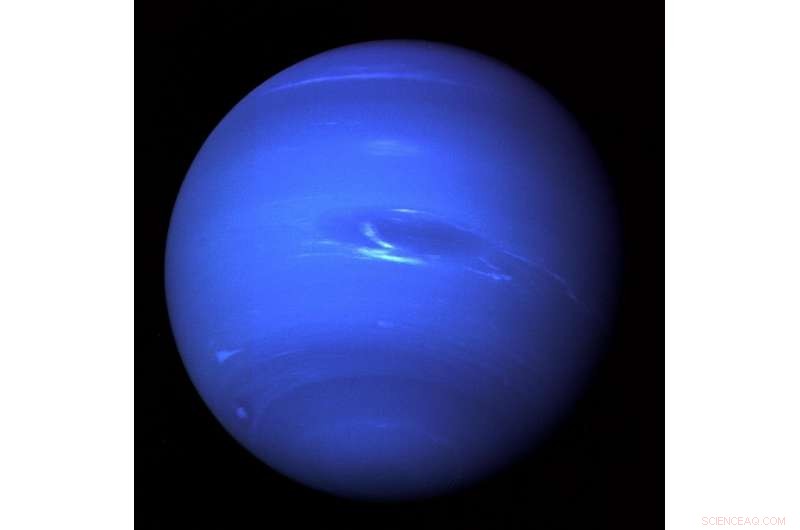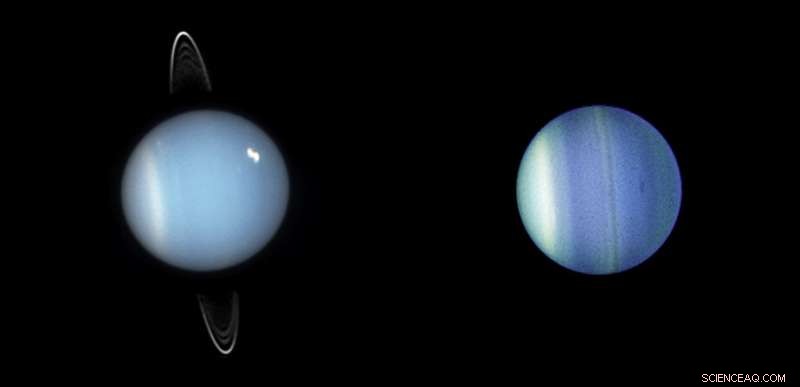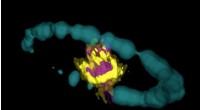Undersøgelse af isgiganter med NASAs Webb-teleskop

Dette Voyager 2-billede af Neptun viser en kold og mørk vindpisket verden. I 1989, NASAs Voyager 2 blev det første og eneste rumfartøj til at observere planeten Neptun, passerer omkring 3, 000 miles over planetens nordpol. Kredit:NASA/JPL-Caltech
Fjerntliggende Uranus og Neptun – vores solsystems isgiganter – er lige så mystiske, som de er fjerne. Kort efter lanceringen i 2021, NASAs James Webb-rumteleskop vil ændre det ved at låse op for hemmeligheder om atmosfæren på begge planeter.
De kolde og fjerntliggende kæmpeplaneter Uranus og Neptun får tilnavnet "isgiganterne", fordi deres indre er sammensat forskelligt fra Jupiter og Saturn, som er rigere på brint og helium, og er kendt som "gasgiganterne". Isgiganterne er også meget mindre end deres gasformige fætre, er mellemstørrelse mellem jordiske planeter og gasgiganterne. De repræsenterer den mindst udforskede kategori af planeter i vores solsystem. Forskere, der bruger Webb planlægger at studere cirkulationsmønstrene, Uranus og Neptuns kemi og vejr på en måde, som kun Webb kan.
"Det vigtigste, som Webb kan gøre det, er meget, meget vanskeligt at opnå fra nogen anden facilitet er at kortlægge deres atmosfæriske temperatur og kemiske struktur, " forklarede undersøgelsens leder, Leigh Fletcher, en lektor i planetarisk videnskab ved University of Leicester i Storbritannien. "Vi tror, at isgiganternes vejr og klima kommer til at have en fundamentalt anderledes karakter sammenlignet med gasgiganterne. Det er til dels, fordi de er så langt væk fra Solen, de er mindre i størrelse og roterer langsommere om deres akser, men også fordi blandingen af gasser og mængden af atmosfærisk blanding er meget anderledes sammenlignet med Jupiter og Saturn."
Alle gasserne i de øvre atmosfærer i Uranus og Neptun har unikke kemiske fingeraftryk, som Webb kan opdage. Afgørende, Webb kan skelne et kemikalie fra et andet. Hvis disse kemikalier produceres af sollys, der interagerer med atmosfæren, eller hvis de bliver omfordelt fra sted til sted af storstilede cirkulationsmønstre, Webb vil kunne se det.
Disse undersøgelser vil blive udført gennem et Guaranteed Time Observations (GTO) program af solsystemet ledet af Heidi Hammel, en planetarisk videnskabsmand og Webb tværfaglig videnskabsmand. Hun er også Vice President for Science ved Association of Universities for Research in Astronomy (AURA) i Washington, D.C. Hammels program vil demonstrere Webbs evner til at observere solsystemobjekter og udøve nogle af Webbs specifikke teknikker til objekter, der er lyse og/eller bevæger sig på himlen.
Uranus:Den skrå planet
I modsætning til de andre planeter i vores solsystem, Uranus – sammen med dens ringe og måner – vippes på siden, roterer i en vinkel på ca. 90 grader fra dets baneplan. Dette får planeten til at rulle som en kugle rundt om Solen. Den mærkelige orientering - som kan være resultatet af en gigantisk kollision med en anden massiv protoplanet tidligt i dannelsen af solsystemet - giver anledning til ekstreme årstider på Uranus.
Da NASAs Voyager 2-rumfartøj fløj forbi Uranus i 1986, den ene pol pegede direkte mod Solen. "Uanset hvor meget Uranus ville spinde, Hammel forklarede, "den ene halvdel var i fuldstændig sollys hele tiden, og den anden halvdel var i totalt mørke. Det er det skøreste, du kan forestille dig."
Skuffende nok, Voyager 2 så kun en glat planet med billardkugle dækket af dis, med kun en ringe håndfuld skyer. Men da Hubble så Uranus i begyndelsen af 2000'erne, the planet had traveled a quarter of the way around in its orbit. Now the equator was pointed at the Sun, and the entire planet was illuminated over the course of a Uranian day.
"Theory told us nothing would change, " said Hammel, "But the reality was that Uranus started sprouting up all kinds of bright clouds, and a dark spot was discovered by Hubble. The clouds seemed to be changing dramatically in response to the immediate change in sunlight as the planet traveled around the Sun."

These Hubble Space Telescope images show the varied faces of Uranus. Til venstre, Uranus in 2005 displays its ring system. The planet -- along with its rings and moons -- is tipped on its side, rotating at roughly a 90-degree angle from the plane of its orbit. In the Hubble close-up taken just one year later, Uranus reveals its banded structure and a mysterious dark storm. Kredit:NASA, ESA, and M. Showalter (SETI Institute); Right:NASA, ESA, L. Sromovsky and P. Fry (U. Wisconsin), H. Hammel (Space Science Institute), and K. Rages (SETI Institute)
As the planet continues its slow orbital trek, it will point its other pole at the Sun in 2028.
Webb will give insight into the powerful seasonal forces driving the formation of its clouds and weather, and how this is changing with time. It will help determine how energy flows and is transported through the Uranian atmosphere. Scientists want to watch Uranus throughout Webb's life, to build up a timeline of how the atmosphere responds to the extreme seasons. That will help them understand why this planet's atmosphere seems to go through periods of intense activity punctuated by moments of calm.
Neptune:A World of Supersonic Winds
Neptune is a dark, cold world, yet it is whipped by supersonic winds that can reach up 1, 500 miles per hour. More than 30 times as far from the Sun as Earth, Neptune is the only planet in our solar system not visible to the naked eye. Its existence was predicted by mathematics before its discovery in 1846. In 2011, Neptune completed its first 165-year orbit since its discovery.
Like Uranus, this ice giant's very deep atmosphere is made of a thick soup of water, ammoniak, hydrogen sulfide and methane over an unknown and inaccessible interior. The accessible upper layers of the atmosphere are made of hydrogen, helium and methane. As with Uranus, the methane gives Neptune its blue color, but some still-mysterious atmospheric chemistry makes Neptune's blue a bit more striking than that of Uranus.
"It's the same question here:How does energy flow and how is it transported through a planetary atmosphere?" explained Fletcher. "Men i dette tilfælde, unlike Uranus, the planet has a strong internal heat source. That heat source generates some of the most powerful winds and the most short-lived atmospheric vortices and cloud features of anywhere in the solar system. If we look at Neptune from night to night, its face is always shifting and changing as these clouds are stretched and pulled and manipulated by the underlying wind field."
Following the 1989 Voyager 2 flyby of Neptune, scientists discovered a bright, hot vortex—a storm—at the planet's south pole. Because the temperature there is higher than everywhere else in the atmosphere, this region is likely associated with some unique chemistry. Webb's sensitivity will allow scientists to understand the unusual chemical environment within that polar vortex.
Just the Beginning
Fletcher advises to be prepared for seeing phenomena on Uranus and Neptune that are totally unlike what we've witnessed in the past. "Webb really has the capability to see the ice giants in a whole new light. But to understand the continual atmospheric processes that are shaping these giant planets, you really need more than just a couple of samples, " he said. "So we compare Jupiter to Saturn to Uranus to Neptune, and by that, we build up a wider picture of how atmospheres work in general. This is the beginning of understanding how these worlds are changing with time."
Hammel added, "We now know of hundreds of exoplanets—planets around other stars—of the size of our local ice giants. Uranus and Neptune provide us ground truth for studies of these newly discovered worlds."
The James Webb Space Telescope will be the world's premier space science observatory when it launches in 2021. Webb will solve mysteries in our solar system, se ud over til fjerne verdener omkring andre stjerner, og undersøge de mystiske strukturer og oprindelsen af vores univers og vores plads i det. Webb is an international program led by NASA with its partners, ESA (European Space Agency) og Canadian Space Agency.
 Varme artikler
Varme artikler
-
 Hjerte af en eksploderet stjerne observeret i 3DRester af Supernova 1987A set af ALMA. Lilla område angiver emission fra SiO -molekyler. Gult område er emission fra CO-molekyler. Den blå ring er Hubble-data, der kunstigt er blevet udvidet til 3D. K
Hjerte af en eksploderet stjerne observeret i 3DRester af Supernova 1987A set af ALMA. Lilla område angiver emission fra SiO -molekyler. Gult område er emission fra CO-molekyler. Den blå ring er Hubble-data, der kunstigt er blevet udvidet til 3D. K -
 Mars -undersøgelse giver spor til mulig livets vuggeDenne opfattelse af en del af Eridania-regionen på Mars viser blokke af dybe bassinforekomster, der er blevet omgivet og delvist begravet af yngre vulkanske aflejringer. Kredit:NASA/JPL-Caltech/MSSS
Mars -undersøgelse giver spor til mulig livets vuggeDenne opfattelse af en del af Eridania-regionen på Mars viser blokke af dybe bassinforekomster, der er blevet omgivet og delvist begravet af yngre vulkanske aflejringer. Kredit:NASA/JPL-Caltech/MSSS -
 Pulsar vindtågerKrabbetågen set i det optiske af Hubble-rumteleskopet. Krabben er et eksempel på en pulsarvindtåge. Astronomer har modelleret den detaljerede form af en anden pulsarvindtåge for at konkludere, blandt
Pulsar vindtågerKrabbetågen set i det optiske af Hubble-rumteleskopet. Krabben er et eksempel på en pulsarvindtåge. Astronomer har modelleret den detaljerede form af en anden pulsarvindtåge for at konkludere, blandt -
 Astronomer finder bevis på atmosfærelignende hylstre omkring galakserKredit:CC0 Public Domain En ny undersøgelse foretaget af forskere ved University of Hertfordshire, offentliggjort i dag i tidsskriftet Astronomi og astrofysik , har fundet beviser på, at de gasf
Astronomer finder bevis på atmosfærelignende hylstre omkring galakserKredit:CC0 Public Domain En ny undersøgelse foretaget af forskere ved University of Hertfordshire, offentliggjort i dag i tidsskriftet Astronomi og astrofysik , har fundet beviser på, at de gasf
- Flare detekteret fra galaksen NGC 3516
- Trump beskyldte skovforvaltningen for dødbringende brande i Californias - men han var forkert
- Airbus afslører banebrydende soldrevne droner
- Stort område og fleksible nær-infrarøde lysemitterende dioder
- Collapsed Mexico school rejser spørgsmål om jordskælvskoder
- Retten beordrer Amazon til at afslutte køb af Wi-Fi-knapper i Tyskland


